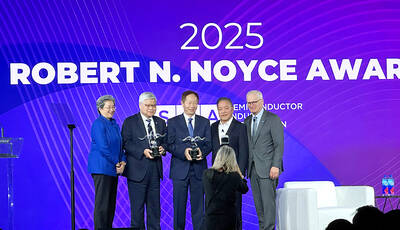US President Joe Biden’s administration is in talks to confer more than US$10 billion in subsidies to Intel Corp, people familiar with the matter said, in what would be the largest award yet under a plan to bring semiconductor manufacturing back to US soil.
Intel’s award package is expected to include both loans and direct grants, the source said. They stressed that negotiations are still under way.
The US Department of Commerce and Intel declined to comment.

Photo: AFP
The incentives would come from the 2022 Creating Helpful Incentives to Produce Semiconductors (CHIPS) and Science Act, which set aside US$39 billion in direct grants as well as loans and loan guarantees worth US$75 billion to get the world’s top semiconductor companies to manufacture chips in the US after decades of production abroad.
Chips firms have invested more than US$230 billion in the US since Biden took office, and the administration’s goal is to establish at least two leading-edge manufacturing clusters by 2030.
Intel dominated the chip industry for years but has recently fallen behind Asian rivals Taiwan Semiconductor Manufacturing Co (台積電) and Samsung Electronics Co, which are building their own US sites in Arizona and Texas. Intel chief executive officer Pat Gelsinger has been the leading industry voice lobbying for US government support of the sector, and the firm has said its plans are contingent on that funding.
Intel is building a US$20 billion facility in Ohio, undergoing a US$20 billion expansion in Arizona and investing US$3.5 billion in New Mexico.
It is not yet clear how Intel’s award would be split between grants and loans, the source said.
Loan terms are company-specific, the source said, as are benchmarks that the Commerce Department would impose to disburse the funding over time.
Intel, based in Santa Clara, California, has not said when its projects would begin commercial production.
The company has made significant progress in Ohio, a spokesperson said after the Wall Street Journal reported a delay from next year to 2026.
An administration official said that the timeline is in bounds with Intel’s initial projections and based on market factors, not award announcements.

Shiina Ito has had fewer Chinese customers at her Tokyo jewelry shop since Beijing issued a travel warning in the wake of a diplomatic spat, but she said she was not concerned. A souring of Tokyo-Beijing relations this month, following remarks by Japanese Prime Minister Sanae Takaichi about Taiwan, has fueled concerns about the impact on the ritzy boutiques, noodle joints and hotels where holidaymakers spend their cash. However, businesses in Tokyo largely shrugged off any anxiety. “Since there are fewer Chinese customers, it’s become a bit easier for Japanese shoppers to visit, so our sales haven’t really dropped,” Ito

The number of Taiwanese working in the US rose to a record high of 137,000 last year, driven largely by Taiwan Semiconductor Manufacturing Co’s (TSMC, 台積電) rapid overseas expansion, according to government data released yesterday. A total of 666,000 Taiwanese nationals were employed abroad last year, an increase of 45,000 from 2023 and the highest level since the COVID-19 pandemic, data from the Directorate-General of Budget, Accounting and Statistics (DGBAS) showed. Overseas employment had steadily increased between 2009 and 2019, peaking at 739,000, before plunging to 319,000 in 2021 amid US-China trade tensions, global supply chain shifts, reshoring by Taiwanese companies and

Taiwan Semiconductor Manufacturing Co (TSMC, 台積電) received about NT$147 billion (US$4.71 billion) in subsidies from the US, Japanese, German and Chinese governments over the past two years for its global expansion. Financial data compiled by the world’s largest contract chipmaker showed the company secured NT$4.77 billion in subsidies from the governments in the third quarter, bringing the total for the first three quarters of the year to about NT$71.9 billion. Along with the NT$75.16 billion in financial aid TSMC received last year, the chipmaker obtained NT$147 billion in subsidies in almost two years, the data showed. The subsidies received by its subsidiaries —

Taiwan Semiconductor Manufacturing Co (TSMC) Chairman C.C. Wei (魏哲家) and the company’s former chairman, Mark Liu (劉德音), both received the Robert N. Noyce Award -- the semiconductor industry’s highest honor -- in San Jose, California, on Thursday (local time). Speaking at the award event, Liu, who retired last year, expressed gratitude to his wife, his dissertation advisor at the University of California, Berkeley, his supervisors at AT&T Bell Laboratories -- where he worked on optical fiber communication systems before joining TSMC, TSMC partners, and industry colleagues. Liu said that working alongside TSMC